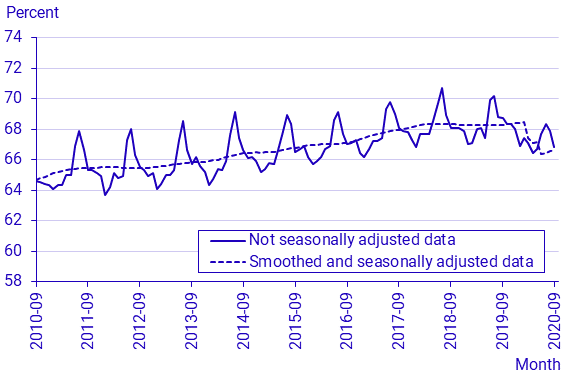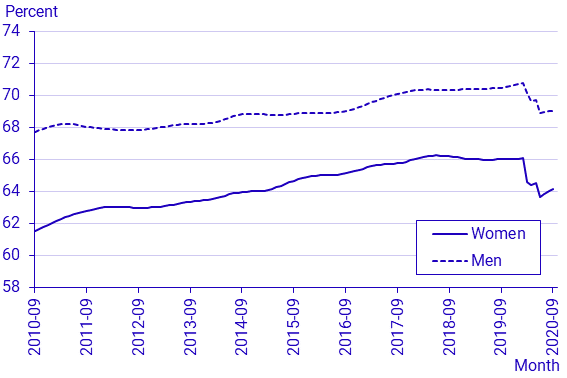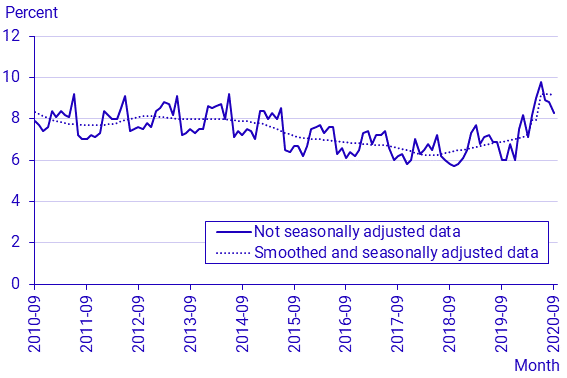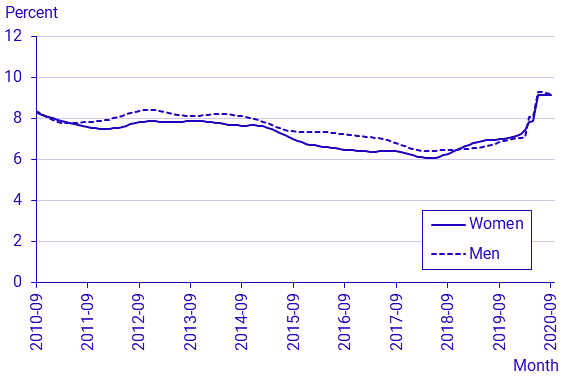Labour Force Surveys (LFS), September 2020
Labour market continues to stabilise
Statistical news from Statistics Sweden 2020-10-15 9.30
In September 2020, there were 5 036 000 employed persons, a decrease of 132 000 compared with September 2019. The number of unemployed persons increased by 122 000 to 453 000. This corresponds to an unemployment rate of 8.3 percent, up by 2.3 percentage points. The average number of hours worked amounted to 165.0 million hours per week, a decrease of 4.7 percent, calendar adjusted. Seasonally adjusted and smoothed data shows employment and unemployment have stabilised. The unemployment rate was 9.2 percent.
The labour force
In September 2020, there were 5 489 000 persons aged 15–74 years in the labour force, not seasonally adjusted. There were 2 900 000 men and 2 590 000 women in the labour force. The relative labour force participation rate was 72.8 percent. Among women, this rate was 69.9 percent and among men the rate was 75.6 percent. Among young people aged 15–24 years, there were 552 000 persons in the labour force, a decrease of 46 000 compared with the same month a year ago. The relative labour force participation rate among young people decreased by 3.9 percentage points and amounted to 47.9 percent.
According to seasonally adjusted and smoothed data, there were 5 533 000 persons in the labour force and the labour force participation rate was 73.4 percent. Neither the number nor the proportion of people in the labour force has shown any decline since the lowest recorded figure was noted in March 2020.
Employment
In September 2020, there were 5 036 000 employed persons aged 15─74 years, not seasonally adjusted. This is a decrease of 132 000 people compared with the same month a year ago. Employment decreased among both women and men. There were 2 386 000 employed women, a decrease of 61 000, and 2 651 000 employed men, a decrease of 71 000. The employment rate decreased by 1.9 percentage points to 66.8 percent. It decreased among women by 1.8 percentage points to 64.4 percent, and among men it decreased by 2.0 percentage points to 69.1 percent. There were 433 000 employed young persons aged 15–24 years, a decrease of 60 000. The employment rate for young persons was 37.5 percent, a decrease of 5.2 percentage points.
According to seasonally adjusted and smoothed data, there were 5 026 000 employed persons. This is a decrease of 130 000 persons, of whom 70 000 were young people, compared with February 2020, when the effects of COVID-19 were not yet discernible in the Swedish labour market. The employment rate was 66.7 percent, a decrease of 1.8 percentage points compared with February 2020. However, neither the number nor the proportion of persons employed has declined further since June.
Employees
In September 2020, there were 4 547 000 employees, not seasonally adjusted. This is a decrease of 101 000 persons compared with the same month a year ago. There were 3 870 000 permanent employees and 677 000 temporary employees.
Compared with February 2020, seasonally adjusted and smoothed data shows there were 126 000 fewer employed persons, of whom 40 000 were permanent employees and 86 000 were temporary employees. As with the employment figures, there have been no significant changes with regard to the number of employees since June.
Hours worked
The average number of hours worked in September 2020 amounted to 165.0 million per week, not seasonally adjusted. This corresponds to a decrease of 4.7 percent, calendar adjusted, compared with the corresponding month a year ago. The largest decrease was noted in the industry Hotels and restaurants, in which the number of hours worked, calendar-adjusted, decreased by 28.8 percent compared with September 2019. The number of hours worked decreased by 17.6 percent in Transport, by 11.4 percent in Manufacturing, mining and quarrying, energy and environment, and by 10.6 percent in Construction.
Seasonally adjusted and smoothed data shows that the average number of hours worked was 147.1 million per week, which is 8.8 million hours less on average per week than in February 2020. However, this decline has slowed in recent months and the lowest rate in 2020 was noted in April.
In work and absence
There were 4 560 000 persons employed and in work in September 2020, not seasonally adjusted. This corresponds to a decrease of 2.9 percent, calendar adjusted, compared with the same month a year ago.
The LFS estimates the number of persons who were absent for the whole week or for part of the week from their principal occupation by main reason for absence. In September 2020, this figure was 1 225 000. There were 485 000 persons absent for the whole week in September 2020, not seasonally adjusted. Among these, 134 000 were absent due to illness and 18 000 were absent for the whole week due to lack of work. There were 114 000 persons absent due to holidays.
It is common for persons who are absent due to lack of work or lay-offs to be absent for only part of the week. There were 113 000 persons in total absent for the whole week or part of the week due to lay-offs. There were 50 000 persons who stated lack of work as their main reason for absence.
Seasonally adjusted and smoothed data shows that there were 4 231 000 persons in work, which is 136 000 fewer than in February 2020. There were 795 000 persons absent for the entire week. In 2020, the lowest number of employed people in work was recorded in April. This figure has since increased by 126 000 people.
Unemployment
In September 2020, there were 453 000 unemployed persons aged 15–74 years, not seasonally adjusted, which is 122 000 more than in the corresponding month a year ago. The unemployment rate was 8.3 percent, which is an increase of 2.3 percentage points. The number of unemployed men increased by 79 000 and amounted to 249 000, and the number of unemployed women increased by 43 000 and amounted to 204 000. Among men, the unemployment rate increased by 2.7 percentage points to 8.6 percent and among women it increased by 1.7 percentage points to 7.9 percent. There were 119 000 unemployed persons aged 15–24 years, which corresponds to a youth unemployment of 21.6 percent.
Among persons aged 15–74 years, seasonally adjusted and smoothed data shows an increase of 111 000 unemployed persons, and an increase in the unemployment rate of 2.0 percentage points compared with February 2020. In September 2020, there were 507 000 unemployed persons, which corresponds to an unemployment rate of 9.2 percent. Among young people aged 15–24 years, seasonally adjusted and smoothed data shows an increase in both the number and the proportion of unemployed persons compared with February 2020. The number of unemployed young people increased by 36 000 and amounted to 161 000, and the unemployment rate increased by 7.1 percentage points to 27.1 percent.
However, seasonally adjusted and smoothed data shows that the unemployment rate has remained unchanged since June 2020.
Impact of COVID-19 on the labour market
In view of the ongoing coronavirus (COVID-19) pandemic, additional questions concerning the impact of COVID-19 have been added to the LFS. Based on these questions, 76 000 employed persons aged 15–74 years stated that they were absent during the whole reference week in September related to COVID-19. This means that among persons who were absent during the entire reference week, 16.0 percent were absent due to COVID-19. The proportion was 20.4 percent for men and 12.8 percent for women.
Among employees aged 15–74 years who were absent during the entire reference week, 12.7 percent, corresponding to 55 000 persons, stated that their absence was linked to COVID-19. The proportion was 14.4 percent for men and 11.6 percent for women. Furthermore, 32.6 percent of employees, which corresponds to 204 000 persons, who were absent during part of the reference week stated that their absence was linked to COVID-19. Among self-employed persons and assisting household members aged 15–74 years, 38.7 percent felt that they had less work due to the coronavirus pandemic, while 15.2 percent felt that they had more work.
To be classified as unemployed in the LFS, a person must be without a job, must be able to start work and must have sought work. This means that people who are without a job, but who have not been seeking work or are not available to start work are not classified as being unemployed, but are classified, instead, as not being in the labour force. In September 2020, 2 050 000 persons aged 15–74 years were outside the labour force. Among these people, 45 000 stated that they would have been available to work, but had not looked for work due to COVID-19.




Next publishing will be
2020-11-19 at 9:30.
Feel free to use the facts from this statistical news but remember to state Source: Statistics Sweden.
